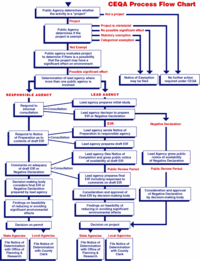The California Environmental Quality Act (CEQA)
This page provides a general overview of California Environmental Quality Act (CEQA). This act requires any development with potential impact to the environment to go through a detailed review process.
Contents
History
- 2012 CEQA Statutes and Guidelines
- Relation to NEPA
- Development of Law
Function of Law
Application Process

Introduction to CEQAnet: online database of the State Clearinghouse which is part of the Governor's Office of Planning and Research.
- Pre-Application Phase
Proposed project has been developed to the point where permit requirements need to be addressed. The potential applicant should identify the types of permits which will be required as well as the agencies associated with the project.
- Application Phase
All required permitting applications are filled to the corresponding agencies. By this time a comprehensive project description must be completed. Agencies which receive applications are charged with concluding if applications are missing information or supporting documents.
- Review Phase
Once an application is completed, a review procedure commences which evaluates the appropriate permitting guidelines and corresponding environmental investigation. Proposed projects are assessed to determine if CEQA applies to them.
Documents
The CEQA process entails the preparation of several documents. These can include:
- Notice of Exemption (NOE)- This notice may be filed when a public agency determines that a project is exempt from CEQA and grants approval for said project. While not required, filing an NOE shortens the statute of limitations for challenging the agency decision from 180 days to 35 days. A NOE can be filed by either the lead agency or the applicant.
- Initial Study- Once a public agency has determined that an activity qualifies as a project under CEQA and is not exempt, an initial study is prepared to determine whether the project may have a significant effect on the environment. The study also identifies possible measures to mitigate impacts to a less than significant level. Based on the outcome of the initial study, one of three documents will be prepared.
- Negative Declaration (ND)- This is completed when the initial study finds no substantial evidence that the project will have a significant effect on the environment.
- Mitigated Negative Declaration (MND)- A MND can be prepared when the initial study has identified potentially significant environmental effects but revisions in the project plans or proposals would avoid potential effects or mitigate them to the level of non-significance. Revisions would have to be made and agreed upon before the initial study and negative declaration are released for public review, and there can be no substantial evidence that the revised project will have significant environmental effects.
- Environmental Impact Report (EIR)- An EIR must be prepared when an initial study shows substantial evidence that significant environmental effects may occur. The report provides information about those effects and possible actions to minimize them and outlines reasonable alternatives to the proposed project.
- Notice of Intent (NOI)- A NOI must be prepared when a lead agency intends to adopt a Negative Declaration or Mitigated Negative Declaration. The notice must be provided to the public, responsible and trustee agencies, and the County Clerk of the county or counties where the project is located.
- Notice of Preparation (NOP)- A document stating that a draft EIR will be prepared for a specific project, and the first step in the EIR process. A NOP must be prepared by the lead agency as soon as it is determined that a project will require an EIR, and should be distributed to each responsible agency and any federal agencies involved in approving or funding the project.
- Notice of Determination (NOD)- A notice filed by the lead agency after the ND, MND or EIR and the project have been approved. The NOD should be filed with the County Clerk where the project will be completed within five days of approval. If approval is needed from state agencies, the NOD should also be filed with the State Office of Planning and Research. [1]
References
Links
- Coastal Case Studies of CEQA Projects in Monterey County, CA
- CEQA projects on Central Coast
- Agencies that are lead applicants in CEQA
- Hydrology and Water Quality Components of Central Coast CEQA Documents
Disclaimer
This page may contain students's work completed as part of assigned coursework. It may not be accurate. It does not necessarily reflect the opinion or policy of CSUMB, its staff, or students.